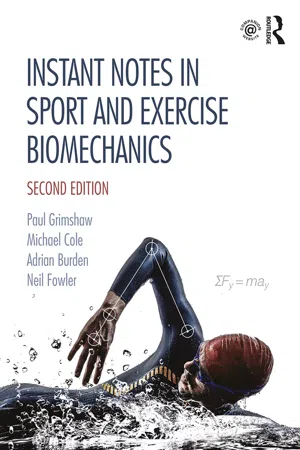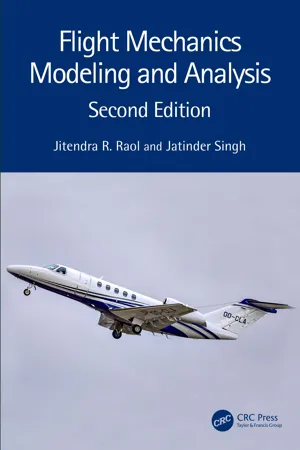Technology & Engineering
Rectilinear Kinematics
Rectilinear kinematics is a branch of mechanics that deals with the motion of objects in a straight line. It involves the study of displacement, velocity, and acceleration of objects moving in a straight line without considering the forces that cause the motion. Rectilinear kinematics is used in various fields, including physics, engineering, and robotics.
Written by Perlego with AI-assistance
Related key terms
3 Key excerpts on "Rectilinear Kinematics"
- eBook - ePub
Instant Notes in Sport and Exercise Biomechanics
Second Edition
- Paul Grimshaw, Michael Cole, Adrian Burden, Neil Fowler(Authors)
- 2019(Publication Date)
- Garland Science(Publisher)
SECTION A Kinematics of linear motionPassage contains an image
A1 LINEAR MOTION Paul Grimshaw Biomechanics can be defined as the study of forces and the effects of these forces on living things. In mechanics, further subdivision includes kinematics and kinetics . Kinematics is the study of displacement, velocity and acceleration (spatial and temporal) while kinetics examine forces, moments and torques. Biomechanics and mechanics are used extensively to study human motion. Figure A1.1 defines biomechanics and kinematics in more detail.Human movement can often be classified into components of linear and angular motion . This leads to a description that is termed general motion. Linear motion (or translation) is movement along a line which may be either straight or curved and where all the body parts are moving in the same direction at the same speed. This can be classified as either rectilinear motion (motion along a straight line) or curvilinear motion (motion along a curved line). Angular motion (discussed elsewhere in this text) involves movement around an axis (either imaginary or real) with body parts (or individual body parts) moving through angles (the same or different angles) in a certain time frame (Figure A1.2 ).Linear kinematics deal with quantities that describe the motion of bodies such as distance , displacement , speed , velocity and acceleration . These can be classified as either scalar or vector quantities. Scalar quantities are represented by magnitude (size) only, whereas vector quantities possess both magnitude and direction. Vector quantities are represented mathematically, as a symbol with a direction sign or graphically by scaled straight lines or arrows. For example, speed is defined as the distance travelled per unit of time (i.e. 12 m/s (metres per second) or 26.8 mph (miles per hour)) - eBook - ePub
- Jitendra R. Raol, Jatinder Singh(Authors)
- 2023(Publication Date)
- CRC Press(Publisher)
3 ]. The chapter ends with a simplified explanation of the physics behind the working of gyroscope.2.2 Kinematics
The kinematics is concerned with the static aspects of mechanics wherein the inherent cause of the motion is not taken into account.2.2.1 Rectangular Cartesian Coordinates
Rectangular Cartesian coordinates are associated with orthogonal xyz axes that are right-handed by convention. Such coordinates are generally used to define position, velocity, and force vectors. For instance, position vector can be defined in terms of its components x, y, and z. Figure 2.1 shows the components of the position vectorR →. Assuming that the components ofR →vary with time, the position vectorR →can be expressed asFIGURE 2.1 Rectangular Cartesian coordinates.(2.1)R →= x( t )i ^+ y( t )j ^+ z( t )k ^wherei ^,j ^, andk ^are unit vectors. It is easy to obtain the velocity vector by differentiating (2.1) for position vector.(2.2)V →= u( t )i ^+ v( t )j ^+ w( t )k ^Further differentiation of the equation forV →shall provide the acceleration(2.3)a →=a x( t )i ^+a yj ^+a zk ^Here,u =,x ˙v =,y ˙w =; andz ˙,a x=x ¨,a y=y ¨a z=z ¨ - eBook - ePub
- D. Gordon E. Robertson, Graham E. Caldwell, Joseph Hamill, Gary Kamen, Saunders Whittlesey(Authors)
- 2013(Publication Date)
- Human Kinetics(Publisher)
PART IKINEMATICSKinematics is the study of motion without regard to causes. Studying human motion in the past was a time-consuming, laborious, and expensive task because cinematography was employed and manual methods were needed to extract the trajectories of body parts from the film. Advances in technology have automated much of the processes of capturing motion data electronically and then extracting the two- or three-dimensional trajectories. Such technology is now commonplace in the motion picture industry, but biomechanists use additional software to obtain time derivatives of the various trajectories or combine the trajectories to reconstruct the motions of body segments and joints so that differences in motion patterns can be readily identified. Kinematics is also the first step to analyses by inverse dynamics (covered in part II ) that estimate the causes of the motion. In this part, chapter 1 outlines how to record two-dimensional kinematics electronically, photographically, and videographically and how to extract digital data from the recordings. Chapter 2 outlines the additional mathematics and processing needed for three-dimensional kinematics. Note that chapter 12 outlines data smoothing techniques that are also important to the valid processing of kinematics, particularly accelerations. Several of the appendixes also have information concerning electronics (appendix C ) and mathematical principles (appendixes D and E) that are required for data collection and analysis in kinematics. Note that text in boldface is a concept described in the glossary at the end of the book.Passage contains an image
Chapter 1Planar KinematicsD. Gordon E. Robertson and Graham E. CaldwellK inematics
Index pages curate the most relevant extracts from our library of academic textbooks. They’ve been created using an in-house natural language model (NLM), each adding context and meaning to key research topics.


